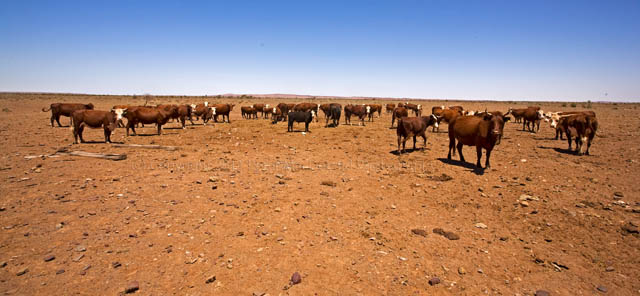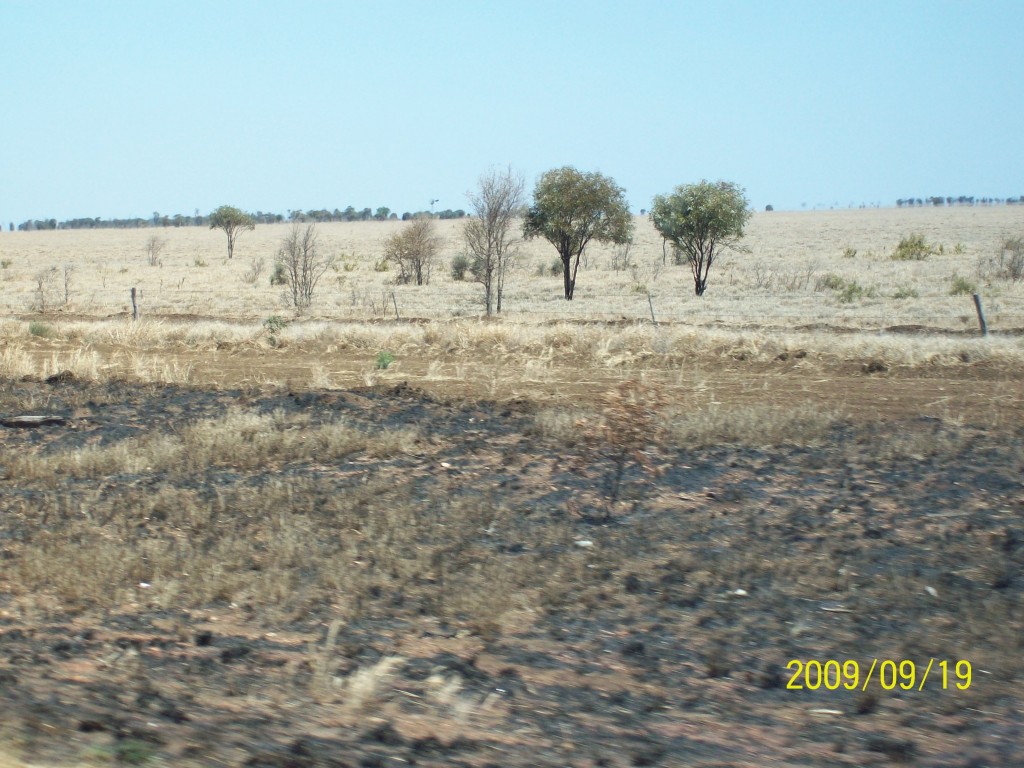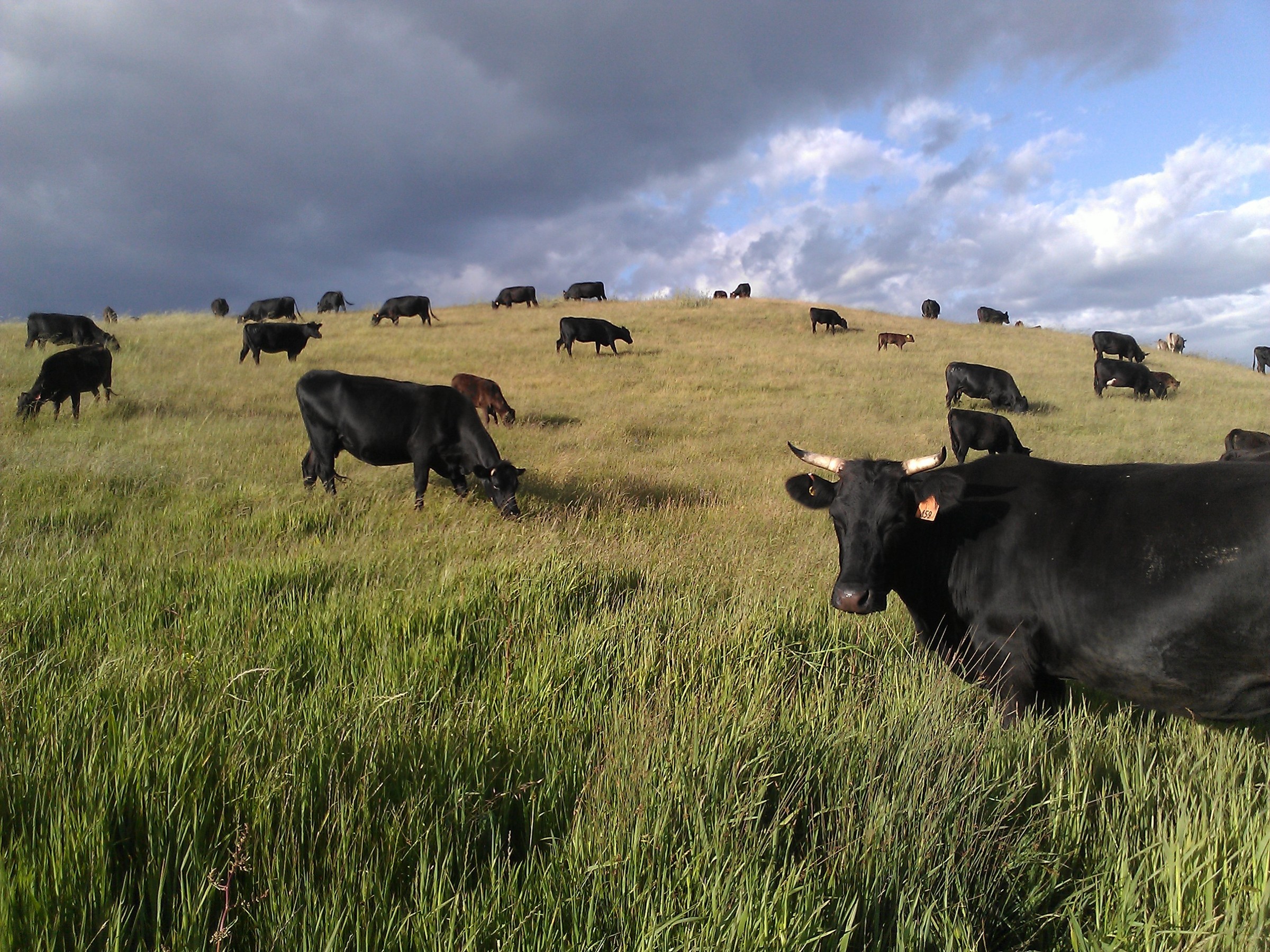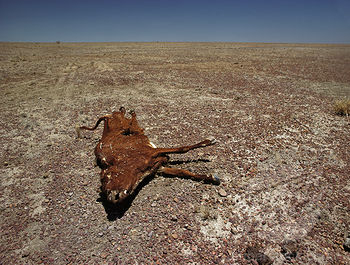Cattle grazing in the desert is cruel and dumb
Friday, June 7th, 2013 Australian cattle with no pasture, no water, no shade, in baking desert heat.
Typical is the wrath of Northern Australian Cattle Farmers.
Southern Australian Cattle Farmers would never allow this treatment to their prized herds.
Australian cattle with no pasture, no water, no shade, in baking desert heat.
Typical is the wrath of Northern Australian Cattle Farmers.
Southern Australian Cattle Farmers would never allow this treatment to their prized herds.
.
<<The Independent Member for Denison, Andrew Wilkie, has joined Lyn White from Animals Australia ( ^http://www.animalsaustralia.org/ ) to release new footage of cruelty to Australian livestock exported to Egypt and announce another attempt to progress legislation to ban the trade.
Mr Wilkie said his Bill would phase out live exports in three years, as well as immediately impose mandatory stunning of Australian livestock slaughtered overseas.
Mr Wilkie:
“The live export industry is systemically cruel, opposed by the vast majority of Australians and not in our economic interests. This latest evidence of horrific animal cruelty in Egypt demonstrates that this trade will never have appropriate animal welfare outcomes and must be stopped.
I have given formal notice of my intention to introduce the Live Animal Export (Restriction and Prohibition) Bill 2013 into Federal Parliament. A similar Bill was rejected by the Government and Opposition in August 2011. Since then we have seen shocking evidence of more live export cruelty in Kuwait, Pakistan, Israel, Egypt and Indonesia.
It is my hope that the Government and Opposition will now see sense and support the end of this cruel trade.”>>
.
[Source: ‘New footage of cruelty to Australian livestock’, by Andrew Wilkie MP, Independent Member for Denison MR, 20130516, Tasmanian Times, ^http://tasmaniantimes.com/index.php?/article/new-footage-of-cruelty-to-australian-livestock/].
.
[Source: Animals Australia, ^http://www.animalsaustralia.org/take_action/cattle-cruelty/].
Outback Marginal Grazing is Unviable
.
- Outback Queensland depends upon the inflated outback cost of diesel to freight cattle hundreds of kilometres to abattoirs or to port for live export
- Australia’s native northern has since colonial times been abused, overgrazed, broadscale burned uncontrollably until the savannah has become desert
- Seasonal drought has struck northern Australia’s savannah yet again, like in 2011 and many times prior – nothing new there.
- Greedy cattle farmers have built up excess herds, creating over-supply in cattle at meatworks, meaning cattle prices have plummeted below the cost of getting them to market
- Indonesia’s live export market was always a short term option as Indonesia built its own herds to a point of self-sufficiency – no news there
- Starved cattle stock with visible bony ribs are currently selling for $20 a head at Longreach. It happened before in the 1974 beef crash – no lessons learnt from that.
- Western Queensland land values have slumped and northern and western Queensland stations — like their excess cattle — are virtually impossible to sell
- Australia’s rural sector is now weighed down with $66 billion of combined debt, many cattle farmers are in a debt crisis and marginial equity in properties
- Bankers are now starting to call in debts, especially in the north, triggering a new round of station sales and mortgagee auctions.
- Three of Australia’s biggest cattle companies, Macquarie Agricultural Fund’s Paraway Pastoral, the stock-exchange listed Australian Agricultural Company and North Australian Pastoral Company have already written down the value of their vast portfolios by a combined $80m.
- AACo announced yesterday that fast-falling cattle prices had forced a $43m writedown of the value of its 600,000-head herd.
- The Cattle Council of Australia yesterday warned that this week’s disastrous $20-a-head sale prices had created a critical situation.
- “These prices are indicative of the critical conditions our northern producers are experiencing; unseasonably dry conditions, suppressed market conditions and the continued fallout from the live trade suspension,” CCA president Andrew Ogilvie said. “I fear that the situation will continue to get worse.”
- A survey by rural bankers Rabobank this week reflected widespread fears of approaching drought. It showed 37 per cent of farmers had lost confidence in the future and expect the next year ahead to be tougher than the past 12 months. About one third expect to suffer a fall in income in 2013-14.>>
.
[Source: ‘Drought stalks the land again’, by Sue Neales, Rural reporter, The Australian newspaper, 20130504, ^http://www.theaustralian.com.au/news/nation/drought-stalks-the-land-again/story-e6frg6nf-1226634963784].
Ain’t a farmer’s duty to leave a place better than how one found it?
.
 Not looking good.
Generations of Cattle Overgrazing of Australia’s Northern Savannah has decimated it to desert.
It’s similar to the 1930s dustbowlers of the American midwest; farmers abused the land and now they expect charity?
Snap out of the family history dogma.
While you have life and limb, relocate to reliably greener pastures!
Not looking good.
Generations of Cattle Overgrazing of Australia’s Northern Savannah has decimated it to desert.
It’s similar to the 1930s dustbowlers of the American midwest; farmers abused the land and now they expect charity?
Snap out of the family history dogma.
While you have life and limb, relocate to reliably greener pastures!
.
[Ed: A previous image here has been removed by us upon becoming aware of its alleged copyright. We obtained the image from the Internet and there were no copyright notices. We noted multiple copies attributable to different sources. Nevertheless we have removed the image immediately and offer our apologies to the owner/s of the image.]
.
Australian Drought Every Decade
.
Australia is subject to seasonal drought commonly at intervals of 11 to 14 years. This has nothing to do with Climate Change theory. Think more El Niño and the varying Pacific Ocean currents and temperatures. The pattern is historically consistent since at least colonisation and probably through millennia.
Major droughts have included 1803, 1809-10, 1813-15, 1826-29, 1835, 1838-39, 1846, 1849-50, 1864-66, 1868, 1877, 1880-86, 1888, 1902, 1911-15, 1918-20, 1937-47, 1965-68, 1982-83, 1991, 1994-2006, 2013.
Australia is the driest continent on Earth. Don’t rural Australian kids get that drummed into them in primary school? Northern Australia’s vast and dry savannah country, inland and west of the Divide is marginal at best for pasture, let alone cropping. Yet after a few bouts of rain, short term memory kicks in. The marginal farmer’s false hope of good timely rain is legendary chronic folklore full of wishful thinking, short term memory loss and denial of Australia’s weather.
.
Occasional rain has become the Marginal Farmer’s Pyrite – fool farmer’s gold.
.
Overgrazing
.
One of the risks associated with arid and semi-arid grazing systems in particular, is land degradation as a result of overgrazing. Overgrazing can be defined as the practice of grazing too many livestock for too long a period on land unable to recover its vegetation, or of grazing ruminants on land not suitable for grazing as a result of certain physical parameters such as its slope.
Overgrazing exceeds the carrying capacity of a pasture. However there may be other factors involved or contributing to apparent overgrazing such as climate change. Overgrazing often results in soil erosion, the destruction of vegetation, and other problems related to these processes.
.
Overgrazing is repeating the US Dustbowl of the ’30s
.
<<Extensive deep plowing of the virgin topsoil of the Great Plains in the preceding decade had displaced the natural deep-rooted grasses that normally kept the soil in place and trapped moisture even during periods of drought and high winds. Rapid mechanization of farm implements, especially small gasoline tractors and widespread use of the combine harvester, were significant in the decisions to convert arid grassland (much of which received no more than 10 inches (250 mm) of precipitation per year) to cultivated cropland.
During the drought of the 1930s, without natural anchors to keep the soil in place, it dried, turned to dust, and blew away with the prevailing winds>>
.
The glut of unwanted cattle is a symptom of an industry run by incompetents. Cattle farmers who put their trust in government and industry big wigs do so at their peril.
.
Australia has only 6% Arable Land
.
<<The Arable land (% of land area) in Australia was 6.14 in 2009, according to a World Bank report, published in 2010.
Arable Land includes land defined by the Food and Agriculture Organization of the United Nations as ‘land under temporary crops (double-cropped areas are counted once), temporary meadows for mowing or for pasture, land under market or kitchen gardens, and land temporarily fallow‘. Land abandoned as a result of shifting cultivation is excluded.>>
.
[Source: ‘Arable land (% of land area) in Australia’, ^http://www.tradingeconomics.com/australia/arable-land-percent-of-land-area-wb-data.html].
. Prime Australian Country for Waygu Beef
Read: ^http://wagyu.une.edu.au/]
Prime Australian Country for Waygu Beef
Read: ^http://wagyu.une.edu.au/]
.
Case Study of Good Rainfall and Sustainable Location
.
Corumbene Brangus Cattle
.
<<At Corumbene Brangus we are dedicated to producing the type of stock that you would be proud to have in your herd. We have taken the time to assess, improve and adapt our breeding herd to the Southern Australian climate and producing cattle of distinction and character that we love.
Our property is situated in the Western District of South West Victoria. We have a high average rainfall of about 30″, with temperature ranging from mid 40’sC (104 Fahrenheit) in summer to low minus in winter. Our pastures are predominately rye and clover kept productive with an extensive pasture renovation and soil conditioning program.
Corumbene Brangus cattle are raised solely on these healthy pastures. Brangus cattle are known for their ability to excel on pasture alone with early finishing and easy fleshing ability no matter what season or time of the year, in all our weather extremes. We calve down during Spring (August-October) each year.>>
.
[Source: Corumbene Brangus, ^http://www.corumbenebrangus.com/cattle.htm].
Observations about MLA’s herded strategy for Northern Australia
.
1. Putting all cattle into a single export market to Indonesia is poor strategy – remember that proverb, don’t put all your eggs in one basket – what action has been taken to develop other export markets?
2. Indonesia has long indicated to Australia that it is breeding towards self-sufficiency in its own live cattle supply, so the decrease in live cattle demand was on the cards, to eventually dry up.
3. Northern Australia’s drought and flood cycle is not new. Farmers must have been aware of the likelihood of drought following the floods of the past four years, so why risk excessive stock?
4. Poor quality control of live export to ensure Australian standards were being met was slack. The strategic risk of discovery of cruel abuse of cattle by an Indonesian abattoir was high. So given that risk, the Meat and Cattle Association (MLA) should have been proactive and diligent in ensuring such abuse was not possible. When abuse is systemic it is only a matter of time before it would be publicly exposed. And the likely consequences of a trade shut down would be been reasonably forseeable.
5. Aside from the above live export has an ongoing record or cruelty and abuse under industry self regulation. So it is always going to be high risk from a social stakeholder perspective. Those who live by the sword…
6. In Australia, in any industry – media, agriculture, mining, forestry- self-regulation never works to the standard expected of Australian society.
.
We have no sympathy for the industry. May the northern Australian cattle industry linked to live trade go bankrupt as it morally deserves.
.
 Once a farmer can inflict such upon his stock, he possesses such evil to do so the same to his children
Once a farmer can inflict such upon his stock, he possesses such evil to do so the same to his childrenCriminal bastardry deserves criminal justice.
<<She won’t mind if the place we stand is marked by ash.
She believes what doesn’t kill her only takes more time to kill her.
Then she smiles as she paints her lips and does her lashes.
Stunning as a taxidermy victim in a silver cage.
I’m arrested by an aria brought from the country.
Stuck in dumb amazement like a dog who’s told to levitate.
This smash number-one goes to her lover in the belfry,
Singing like a bird in flames and headed for the window pane.
In the coming years, let’s try and milk a fortune off them.
I think we’re qualified by now.
Alouette, gentille alouette.
Head to toe so thoroughly until we’re both dismembered.
Alouette, gentille alouette.
Naá¯ve, yes, but none the worse, spinning glue back into horses.
I’ll never leave the place where you are.
Hand-in-hand into a rented car.
Merrily into the abattoir.
Spilling out all over, I’ll be Noah on the storm.
And two-by-two in love we’ll speed back into bed and never leave it.
In the coming years, let’s try and milk a fortune off them.
I think you’re qualified by now.
Alouette, gentille alouette.
Head to toe so thoroughly until we’re both dismembered.
Alouette, gentille alouette.
Naá¯ve, yes, but none the worse, spinning glue back into horses.
Alouette, gentille alouette.
Head to toe so thoroughly until we’re both dismembered.
Alouette, gentille alouette.
Alouette, gentille alouette.>>
.
[Source: The Pernice Brothers’, Cruelty To Animals’]
.
[Ed: My father’s family heritage was sheep farming in Victoria’s west dry marginal Wimmera and our sheep farming roots extended back to 18th Century England. That tradition ended under tragic circumstances near Stawell in 1942; yet in hindsight, subsequent generations of our family are far better for it. Relocating takes more guts than putting up. Honour is more deserving of our future generation; the oldies should understand.]










